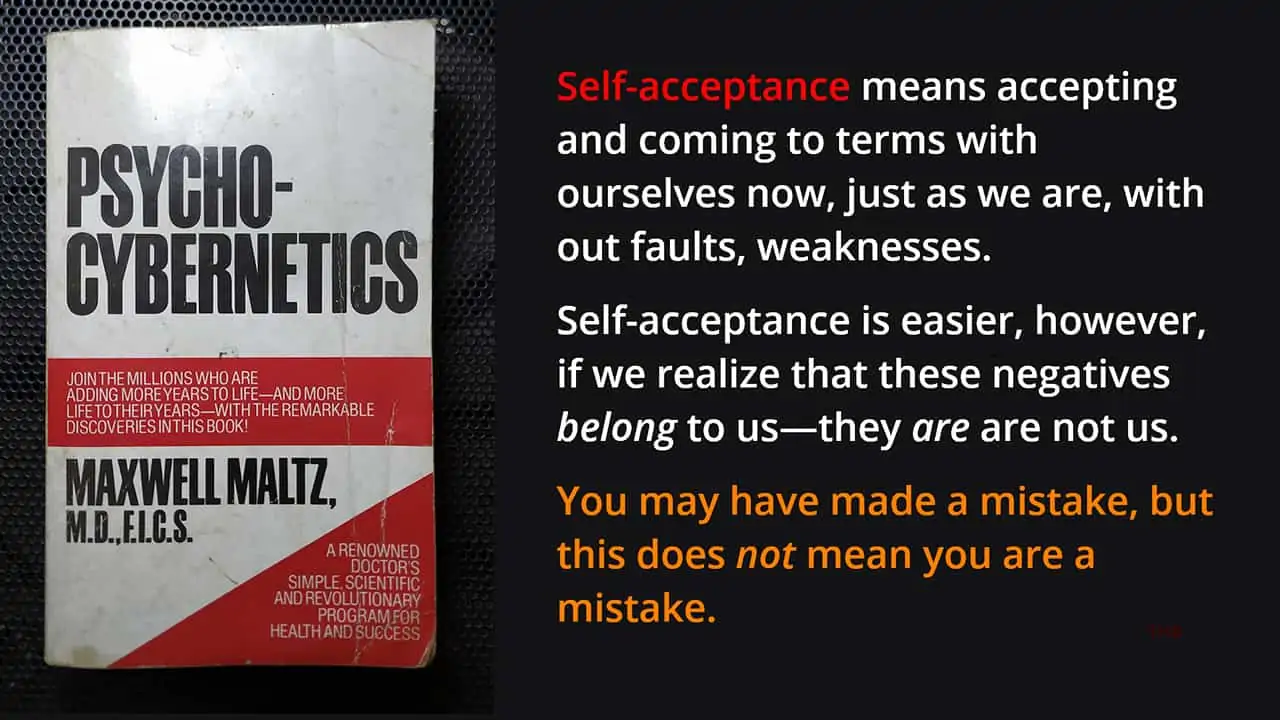Today's Sunday • 14 mins read
— By Dr. Sandip Roy.
Some people get success after success easily, while others struggle. Why?
Maxwell Maltz’s classic bestseller “Psycho-Cybernetics” explains the why. And also solves the how.
What you’re going to read below is an in-depth summary of Psycho-Cybernetics. It includes all of Maltz’s lessons on how to switch into an abundance mindset and become your most successful version.
Free PDF: Summary of Psycho-Cybernetics: Mindset Mastery Made Easy
Quick Summary of Psycho-Cybernetics
Psycho-Cybernetics, by Maxwell Maltz, explains how our self-image (our beliefs about ourselves) acts as a mental blueprint for our actions and success. It suggests that if we consciously enhance our self-image, it can autopilot us to our goals and a happier life. It shares tools to help us change our self-image, such as visualization and mental rehearsal.
“Your self-image determines your self-worth.”
— Maxwell Maltz, “Psycho-Cybernetics”
Detailed Summary of Psycho-Cybernetics
Maltz merged machine principles (cybernetics) with self-image psychology to form Psycho-Cybernetics. He defined it as the act of “steering your mind to a productive, useful goal so you can reach the greatest port in the world: peace of mind.”
Psycho-Cybernetics proposes that:
- Self-image is a key factor in our success. Our self-image, which is our beliefs about our abilities and potential, is a mental blueprint for our actions and outcomes. We often build a negative self-image through self-criticism and negative self-talk, which conditions us to poor outcomes.
- Cybernetic principles. Maltz explains that our brain is a servo-mechanism that automatically moves towards a goal, whether consciously set or unconsciously adopted. He concluded this by applying the principles of cybernetics, or machine control systems, to the human mind.
- Automatic Success Mechanism. Psycho-Cybernetics proposes that when we properly program a positive self-image, it can guide us towards success. This is our “Automatic Success Mechanism.” Conversely, a negative self-image can lead to an “Automatic Failure Mechanism” and repeated failures.
- Visualization and Mental rehearsal. Maltz shares that tools like visualization and mental rehearsal can build a positive self-image. It involves repeatedly imagining ourselves achieving our goals and behaving in desired ways to reprogram our subconscious for positive outcomes.
- Changing limiting beliefs. Psycho-Cybernetics also asks us to identify and change the negative or limiting beliefs about ourselves. It involves challenging our negative self-talk and replacing it with more positive and empowering affirmations.
- Forgiveness and Healing. Maltz also asks us to forgive others and ourselves. He emphasizes that forgiveness helps heal emotional wounds and develop a more positive self-image.
- Goal Setting and Action. Psycho-Cybernetics needs us to set clear goals and take goal-directed action aligned with our desired self-image. It asks us to be more solution-oriented than problem-focused.
How Psycho-Cybernetics Works?
Psycho-cybernetics works by training your subconscious mind with conscious instructions.
Imagine your subconscious mind as a big elephant and your conscious mind as its little human mahout.

Like the elephant that moves as per its mahout’s directions, our subconscious mind dutifully follows the instructions we feed it consciously.
- The subconscious mind, like the powerful elephant, has immense power and potential. It can operate automatically, process vast amounts of information, and accomplish remarkable feats. But it cannot work well without proper instructions.
- The conscious mind, like the human mahout, is the rational, decision-making part of the mind. It can train, direct, and guide the subconscious mind toward specific goals and outcomes, harnessing its power effectively.
The Interesting Origin Story of Psycho-Cybernetics
Dr. Maxwell Maltz was a popular cosmetic surgeon. He noticed that when some of his patients met him after surgeries, they had become entirely new people. They had new behaviors, attitudes, habits, and lifestyles.
But what motivated them? As he dug in to know more, he realized:
When they saw a more beautiful self-image (in the mirror), their minds started “beautifying” the other parts of their lives.
Maltz understood now that they made these changes in their persona to match their better-looking faces. This led him to conclude that the human mind operates like a “servo mechanism” that tunes one’s entire life in sync with their self-image.
Servo-mechanisms are so constructed that they automatically “steer” their way to a goal, target, or “answer.”
— Maxwell Maltz, “Psycho-Cybernetics”
How To Use Psycho-Cybernetics To Succeed In Life
The strategy to harness the “psycho-cybernetics” system:

- A. Analyze your current self-image.
- B. Bring into play psycho-cybernetics.
- C. Create a brand new, positive self-image.
A. Analyze Your Self-Image
Answer these questions to review your self-image:
- Do I see a successful person in my mental mirror?
- In twenty words or less, who am I (only I will read it)?
- What are six of my most limiting opinions and beliefs?
- What do I believe about money, happiness, and success?
- Can I commit to doing what I say I will do for my success?
- How do I treat myself: with kindness, harshness, or criticism?
- Am I aware of what people think about me (did I ask others)?
- Do I blame others, situations, or past failures for my present state?
- What stories do I tell people about myself (are those entirely true)?
- Does this fear lurk in my mind that I will fail, no matter how hard I try?
Then write down in a few sentences what your self-trapping beliefs are. Examples below:
- I think I am unlucky.
- I think I am unlovable.
- I think I have no talent or expertise.
- I think I’m not made for success, fame, or a rich life.
- I think people would mock me for having lofty goals.
Maltz suggests how to deal with your negative self-beliefs:
- Realize that your negative self-belief is not a fact.
- Stop letting your negative self-belief define your self-image.
- You can change your self-beliefs, no matter where they came from.
B. Bring Into Play Psycho-Cybernetics
This step is about feeding your subconscious mind with a new manual.
1. Replace Unhelpful Beliefs:
Try to see the bright side of bad things.
Swap your limiting belief from your earlier self-analysis, say “I’m not good enough,” with an empowering one, like “I am capable and improving every day.”
For example, “I see this failure as a teaching moment for my next attempt.”
Write this new belief down and repeat it aloud twice daily, ideally in the morning and before bed, to start reprogramming your subconscious.
Over time, as Maxwell Maltz suggested, this deliberate shift acts like updating software, allowing your mind’s guidance system to steer toward positive outcomes rather than self-sabotage.
2. See Your Ideal Self:
Close your eyes in a quiet space and vividly imagine yourself embodying the traits you desire.
Do you want to have more confidence or resilience? Then picture your posture to the reactions of others around you.
Spend five to ten minutes daily on this mental rehearsal, engaging all senses to make the scene feel real, much like an athlete visualizing a perfect performance.
This will feed your subconscious a clear target, automatically adjusting your behaviors to align with that ideal image.
3. Create Affirmations:
Craft short, positive statements in the present tense that reflect your goals, for example, “I handle challenges with ease and creativity.”
Personalize them based on your self-image analysis, ensuring they counteract specific negative beliefs, and jot them on sticky notes placed where you’ll see them often, like your mirror or phone screen.
Recite these affirmations with genuine emotion during moments of relaxation, reinforcing the new manual for your mind’s servo-mechanism to foster lasting change.
4. Reflect on Successes:
Set aside time each evening to recall three past achievements, no matter how small.
Find time to journal about what skills or qualities made your past successes possible. Focus on the feelings that you had when you accomplished each.
This reflection creates a positive feedback loop. It trains your subconscious to recognize and build upon your strengths.
Gradually, incorporate these successes into your daily visualizations, creating a bridge between proven wins and future aspirations.
5. Challenge Negative Thoughts:
When a pessimistic idea arises, pause and question its validity by asking, “Is this based on facts or old habits?”
Then, reframe it constructively. For instance, turn “I’ll never succeed” into “What can I learn to improve next time?”.
Note down the shift in a dedicated thought journal.
Consistently interrupting negative thought patterns disrupts their automaticity. And allows your psycho-cybernetic system to redirect energy toward growth and resilience.
6. Seek New Experiences:
Step outside your comfort zone by trying one novel activity weekly, such as joining a class or networking event, to expose your mind to fresh evidence of your capabilities.
Observe and record how these experiences contradict limiting beliefs, using them as real-world data to update your subconscious programming.
As Maltz observed, this active exploration acts like calibration for your internal guidance system, fine-tuning it to navigate toward expanded possibilities with greater accuracy.
7. Practice Self-Compassion:
Treat yourself with the kindness you’d offer a close friend during setbacks by speaking gently, perhaps saying, “It’s okay, you’re learning,” instead of harsh criticism.
Incorporate brief daily rituals, like a mindful breathing break, to nurture this habit and reduce self-judgment.
Maltz highlighted that self-compassion clears emotional static, enabling your subconscious to receive and act on positive directives more effectively.

C. Create A New Self-Image
Some steps to build and solidify a new, positive self-image are:
- Decide To Reset: Consciously decide to reset the unhelpful parts of your current self-image.
- Positive Visualization: Start regularly visualizing a confident, successful version of yourself.
- Embrace New Roles: Actively take on roles and responsibilities that match your new self-image.
- Positive Peer Influence: Surround yourself with people who reflect the qualities you aspire to.
- Affirmation and Action: Combine affirmations with actions that reinforce your new self-image.
- Celebrate Small Wins: Own and celebrate even small achievements that match your new self-image.
- Record Progress: Keep a journal of your growth and changes in self-perception.
- Embrace Change: Be open to evolving and refining your self-image as you grow.
“To really live, that is to find life reasonably satisfying, you must have an adequate and realistic self-image that you can live with. You must find your self acceptable to you.”
— Maxwell Maltz

Case Study On Self-Image Transformation
Maxwell Maltz tells a story about his friend, Dr. Alfred Adler. Adler was a well‑known psychiatrist and neurologist. He founded Individual Psychology.
In school, Adler struggled with math. His teacher saw him as a student who disliked math and lacked talent. Adler believed this view. He began to think he would always be bad at math.
One day, he solved a hard problem. It shocked his teacher and him. That win gave him confidence. He changed his limiting self‑image and improved at math.
Maltz says that at any age, seeing true worth can spark big personal growth. As he writes, “one is never too young nor too old to change his self‑image and thereby start to live a new life.”
Later, Adler coined two terms we still use today: inferiority complex and superiority complex.
My best lesson from the book will always be this: You may have made a mistake, but this does not mean you are a mistake.

Taking steps is the only way to achieve your goals.
Positive Affirmations
Positive affirmations are short and simple positive declarations to yourself. They replace your negative self-talk with empowering beliefs.
Choose affirmations that feel real and convincing to you, or else you would be reluctant to repeat them. Repeat them daily to let them sink into your subconscious mind.
Some examples of positive affirmations:
- “I am worthy of success.”
- “I am confident and capable.”
- “I am attracting abundance into my life.”
- “I am achieving my goals one step at a time.”
Focus on the emotional side of your affirmations. Your subconscious receives the message more strongly when you feel the emotions you’d get with your desired result.
Mental Rehearsal
Mental rehearsal is like a “dry run” for your desired outcomes, where you visualize each step of your journey towards goals in your imagination.
How To Practice Mental Rehearsal:
- Set a few clear goals: Define what you want to achieve, and be specific. The more detailed your goal, the better you can rehearse it.
- Close your eyes and relax: Find a quiet place and get comfortable. Close your eyes and focus on your breath to calm your mind and enter a relaxed state. Maltz says, “Scientific experiments have shown that it is absolutely impossible to feel fear, anger, anxiety, or negative emotions of any kind while the muscles of the body are kept perfectly relaxed.”
- Visualize the process in detail: Imagine yourself completing each step of your goal. See yourself taking action, feeling emotions, and experiencing the positive outcome in vivid detail. Engage all your senses—sight, sound, smell, touch, and even taste—to make the visualization as real as possible.
- Feel the emotions: Immerse yourself in the positive emotions you would feel upon achieving your goal. Feel the confidence, joy, and satisfaction of reaching your desired outcome.
- Repeat and refine: Practice your mental rehearsal regularly. The more you do it, the more your subconscious mind will be programmed for success. As you practice, you can refine your visualization and make it even more vivid and powerful.
Tips for Effective Mental Rehearsal:
- Daily visualization: Dedicate time each day to practice mental rehearsal.
- Start small: Start with simple goals to build your confidence in the technique.
- Be specific: Visualize in clear detail to make your mental rehearsal more effective.
- Feel the emotions of success: Imagine and embrace the positive emotions of success.
- Diverse Scenarios: Practice with different success aspects/scenarios to build versatility.
- Reflect on Progress: After a few days, track your progress and reflect on insights gained.
How To Make Your New Self-Image Attract Success?
- Stop comparing yourself to others. Embrace your uniqueness. Maltz’s advice, “You as a personality are simply not in competition with any other personality because there is not another person on the face of the earth like you.”
- Keep tuning your self-image positively. Keep enhancing your self-image. Increase your optimism, positive outlook, and self-belief. Take mistakes as feedback to fine-tune and autocorrect.
- Use the brain’s feedback mechanism: Actively give your brain feedback. The brain stores successful responses and learns what to do more of and what to stop.
- Trust your journey. Psycho-cybernetics works, so start to believe in its efficacy. Let it work automatically after installing a positive self-image, without forcing it to work.
Learned Helplessness: Self-Image of A Failure
Martin Seligman, the Father of Positive Psychology, found out that dogs learn to feel helpless in certain situations.
- First, dogs were put in a box and given electric shocks, from which they could escape by jumping over a low partition.
- Then, they were given shocks and not allowed to escape. Gradually, as the dogs found they could not escape the shocks, they lay down whimpering, feeling helpless.
- Later, when these “helpless” dogs were put into boxes with a low partition that they could jump over, and given shocks, they did not try to escape and instead lay whimpering. These dogs had learned helplessness.
Seligman said this may be similar in humans too, where people experiencing uncontrollable negative events become passive and give up trying to improve their situation.
Seligman’s idea was similar to Maltz’s. Maltz had earlier suggested that our self-limiting beliefs are at the root of our failures.
FAQs
1. What is Psycho-Cybernetics?
“Psycho-cybernetics” refers to our mind’s automatic success mechanism that can help us live richer and happier lives. We can instruct our minds to create a positive self-image. This then helps us achieve our goals on autopilot.
2. Who was Maxwell Maltz?
Maxwell Maltz was born in Brooklyn, New York, in 1909. He received his medical degree from Columbia University in 1934. Maltz specialized in cosmetic surgery and was a busy practitioner. His book Psycho-Cybernetics came out in 1960, became a bestseller, and was named one of the 50 Best Self-Help Classics of all time.
Final Words
Psycho-cybernetics has influenced nearly every major “self-help” expert, from Zig Ziglar to Brian Tracy to Tony Robbins to James Clear. Maltz’s work has touched the lives of more than thirty million readers.
- Self-image is the mental blueprint for success and goal achievement.
- A “cosmetic surgery on self-image” can enhance our chances of success and fame.
- Often, a person’s full potential can be limited by negative self-talk due to past failures.
- The success system can be activated via mental rehearsal of psycho-cybernetics principles.
The “self-image”, the individual’s mental and spiritual concept or “picture” of himself, was the real key to personality and behavior.
— Maxwell Maltz, “Psycho-Cybernetics”
√ Also Read:
- Psycho-Cybernetics: Quotes To Thrive Every Day of The Year
- How To Overcome Negative Self-Talk With Psycho-Cybernetics
√ Please spread the word if you found this helpful.

